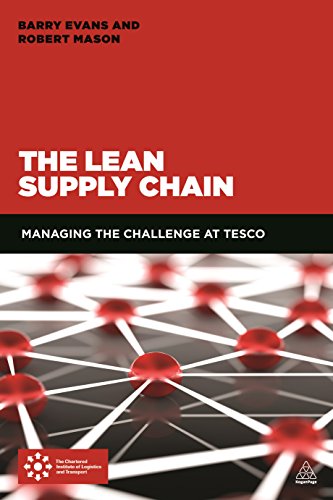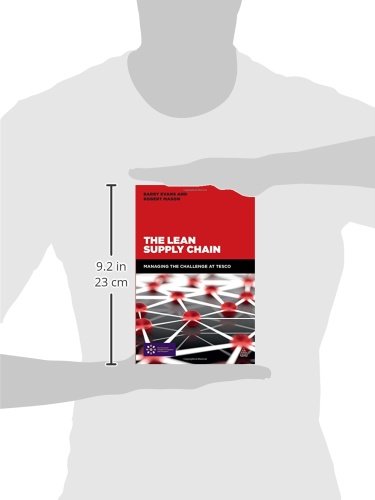Customer Services
Copyright © 2025 Desertcart Holdings Limited
Desert Online General Trading LLC
Dubai, United Arab Emirates




Full description not available
K**R
A Fair Balance of Scandal Coverage and Cross-Industry Best Practices
The supply chain may be the best organized in the world, but if trust and transparency are not there the commercial results will not materialize.- The Lean Supply Chain, p. xxivThe Lean Supply Chain: Managing the Challenge at Tesco (September 3, 2015, Kogan Page) by Robert Mason and Barry Evans is fascinating – for its timing as much as the overview it provides into one of the world’s most prominent retailers. The book’s timing is impressive (and critical) given the turbulent few years Tesco has had: including the horsemeat scandal in 2013, and an accounting scandal in 2014.While this book is not solely about the scandals and their exact aftermath, it acknowledges them right up front and includes as many details as the publication timeline would allow – and probably a few more than that. The Preface is an absolute must-read and would stand as a B-school case study in its own right.The basis of the book is the result of joint research done by Tesco and Cardiff Business School in the U.K. Author Barry Evans worked for Tesco’s supply chain organization for a decade. There is clear admiration for Tesco on the part of the authors, resulting in a book that is more of a calm investigation of a complex supply chain’s strengths and weaknesses than a post-crisis exposé.The authors start by clarifying that their (and presumably Tesco’s) definition of supply chain is broader than usual, inspired by Michael Porter’s ‘value chain’ approach.The grocery retail industry is highly competitive and operates on razor thin margins. Since, as pointed out in the book, the products offered are effectively commoditized, Tesco has had to differentiate on services, the environment in their stores, and the end-to-end consumer experience. Their investments into improving consumer sentiment are central to their business strategy.The other core element of Tesco’s strategy is simplicity: even when they are addressing complexity. It must be simple to convert decisions into actions, and therefore systems and processes do not need to be overly complicated. In fact, this becomes a built in feedback cycle. Tesco believes in immediately converting insight into action and then they track the impact of their actions to see if they had the desired effect.From an inside business perspective, Tesco applies simplicity in the alignment of goals, objectives, and KPIs across functions. In fact, Tesco believes that having different goals/objectives for each function allows one group to soar while another sinks. In the end, if all groups are not functioning well together and independently, the end service provided to the customer suffers.Tesco has always leveraged data in their pursuit of customer value creation. Back as far as the late 1990’s they were treading into early ‘big data’ waters, looking at huge volumes of shopper data from their loyalty card program but needing to build a program and the supporting capabilities to apply it effectively.The Lean Supply Chain somehow manages to offer lessons and best practices that are relevant across industries and functions while telling the Tesco supply chain story sympathetically and in-depth.
D**M
Recommendable
Tesco is a major British supermarket that had enjoyed a period of rapid growth in recent years, requiring the use of a highly organised, functional supply chain to keep the shelves of its stores laden with goods. This book takes a look at both the art and science of operating a Lean-inspired, functional supply chain and shows how a large retailer could utilise and benefit from this activity.This is written with a fairly specialist, narrow audience in mind. It is by no means beginner-friendly, yet with a degree of perseverance it could still be a little goldmine for the uninitiated. For those who need to live and breathe this stuff, await the experience! The authors have done a good job in crystallising the way the company and its senior management team pivoted from focussing on their competitors and how to beat them to putting the customer’s needs truly in the spotlight and working to service them. This change required the support of an efficient supply chain. The whole process is placed under the microscope from origin to the modern day, from improvement processes to the things that did not go according to plan. It is quite a candid, open read.It might be fair to describe this book as a mega case study about Lean concepts, with strategy, business development, marketing and operations all bolted on for good measure and a living, breathing subject used to highlight the theory and show how it can be used in practice. For a company of Tesco’s size, changes can offer a dramatic change to its bottom line, such as switching to a daily delivery from suppliers shaved GBP 400m off its cost base. Savings could be found in many areas, such as how items are stocked on shelves, how logistics are coordinated and how smaller batch-produced items provided at a higher frequency were better and more able to keep up in demand.Even the smallest of companies can potentially learn a lot from this book, even if the savings are more modest. It is hard to give this book anything other than a ringing endorsement. As you will expect from a Kogan Page book, it is cleanly designed and comes complete with a highly detailed index and a packed bibliography.So, a specialist read that many generalists would also benefit from reading.
M**G
Fantastic
Well written, to the point
Trustpilot
3 days ago
5 days ago